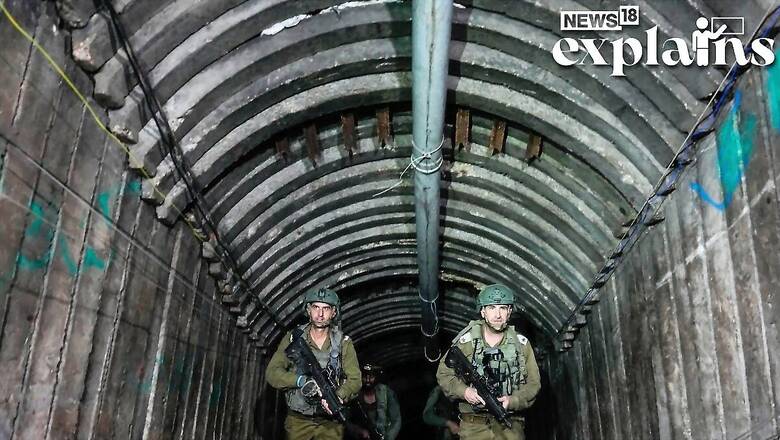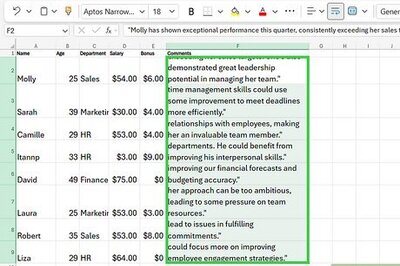
views
Israel’s army on Sunday said it had found a large Hamas tunnel in Gaza as it pressed its offensive in Gaza amid growing international calls for a ceasefire and rescue remaining hostages.
The huge tunnel was discovered near the busy border crossing at Erez into Israel, raising concerns over how Israeli surveillance missed such preparations by Hamas for the militant attack on October 7, which led to the war for last three months.
The tunnel was a part of Hamas’ “strategic infrastructure” and would be destroyed, the Israel Defense Forces (IDF) said. In a video shared by the IDF, the Israeli military claimed that the tunnel was created for Hamas troop movements and as a launching point for attacks.
What to Know About Hamas’ Tunnel?
The tunnel stretches for more than four kilometres, links up with a sprawling tunnel network across Gaza and is wide enough for cars and heavy equipment to travel through it along with railroad-like tracks, electricity and ventilation systems.
EXPOSED: The biggest Hamas terrorist tunnel discovered.This massive tunnel system branches out and spans well over four kilometers (2.5 miles). Its entrance is located only 400 meters (1,310 feet) from the Erez Crossing—used by Gazans on a daily basis to enter Israel for work… pic.twitter.com/RcjK5LbvGL
— Israel Defense Forces (@IDF) December 17, 2023
Footage shared by the IDF and allegedly filmed by Hamas to show the construction of the tunnel shows a large vehicle driving into the tunnel and a makeshift railroad inside it.
This tunnel system was a project led by Mohammad Sinwar, the brother of Hamas leader Yahya Sinwar and the commander of Hamas’ Khan Yunis Battalion.
The entryway to the tunnel is just a few hundred meters from the heavily fortified Erez crossing and a nearby Israeli military base. The entrance to the tunnel, a circular cement opening leading to a cavernous passageway, was located under a garage, hiding it from Israeli drones and satellite images.
Israel said the tunnel cost millions of dollars and took years to construct, featuring rails, electricity, drainage and a communications network. It also said that the destruction of Hamas’ tunnel network is a major objective and that much of the underground network runs beneath schools, hospitals and residential areas.
How Was the Tunnel Crucial?
Israeli military spokesperson Nir Dinar said the tunnel was twice the height and three times the width of other tunnels found in Gaza.
The tunnel was equipped with ventilation and electricity and dives 50 meters underground at some points. He said it was clear that millions of dollars as well as a great deal of fuel and workforce had been needed to build and sustain the tunnel.
The tunnel facilitated the transit of vehicles, militants and supplies in preparation for the October 7 attack.
During the October 7 raids, Hamas militants used the tunnel to fire rocket-propelled grenades to break past the portion of the wall close to the Erez crossing and stormed the base, killing at least three soldiers and kidnapping some back to Gaza.
The crossing was one of several places along the border wall where militants easily blew past Israel’s security defences and entered Israeli territory killing around 1,200 people and taking about 240 others hostage.
The Erez crossing with its fortress-like facility that processed the movement of Palestinians into Israel for work, medical care and transit to neighbouring Jordan had a great symbolic value for Hamas. The border crossing was protected by security cameras and military patrols and the adjacent military base.
Hundreds of Hamas Tunnel Destroyed
The IDF claims to have exposed “hundreds of terror tunnel shafts throughout the Gaza Strip” and says it is operating “to locate and destroy dozens of attack tunnel routes.” The Israeli military said they have discovered at least two other “city-sized” tunnels of similar in scope, which they are still mapping.
Since the Israel-Hamas war began, Israel said it has uncovered more than 800 tunnel corridors across Gaza, all entrances to the estimated 300-mile-long subterranean system operated by Hamas militants.
More than 500 of those corridors have been destroyed while the Israeli military is pumping seawater into the tunnels to destroy the “Gaza metro.”
Gaza’s ‘Metro’
Hamas has claimed to have built 500 kilometres worth of tunnels under Gaza, though it is unclear if that figure was accurate. If true, Hamas’ underground tunnels would be a little less than half the length of the New York City subway system.
The tunnels under Gaza are used to transport people and goods; to store rockets and ammunition caches; smuggle goods from Egypt; launch attacks into Israel and house Hamas command and control centres, all away from the prying eyes of the IDF’s aircraft and surveillance drones.
Experts say that diggers using basic tools likely burrowed deep underground to dig the network, which is wired with electricity and reinforced by concrete. Israel has long accused Hamas of diverting concrete meant for civilian and humanitarian purposes toward the construction of tunnels.
Some of those taken hostage in the October 7 attacks described being taken to them and being forced to march for hours.
(With inputs from agencies)


















Comments
0 comment